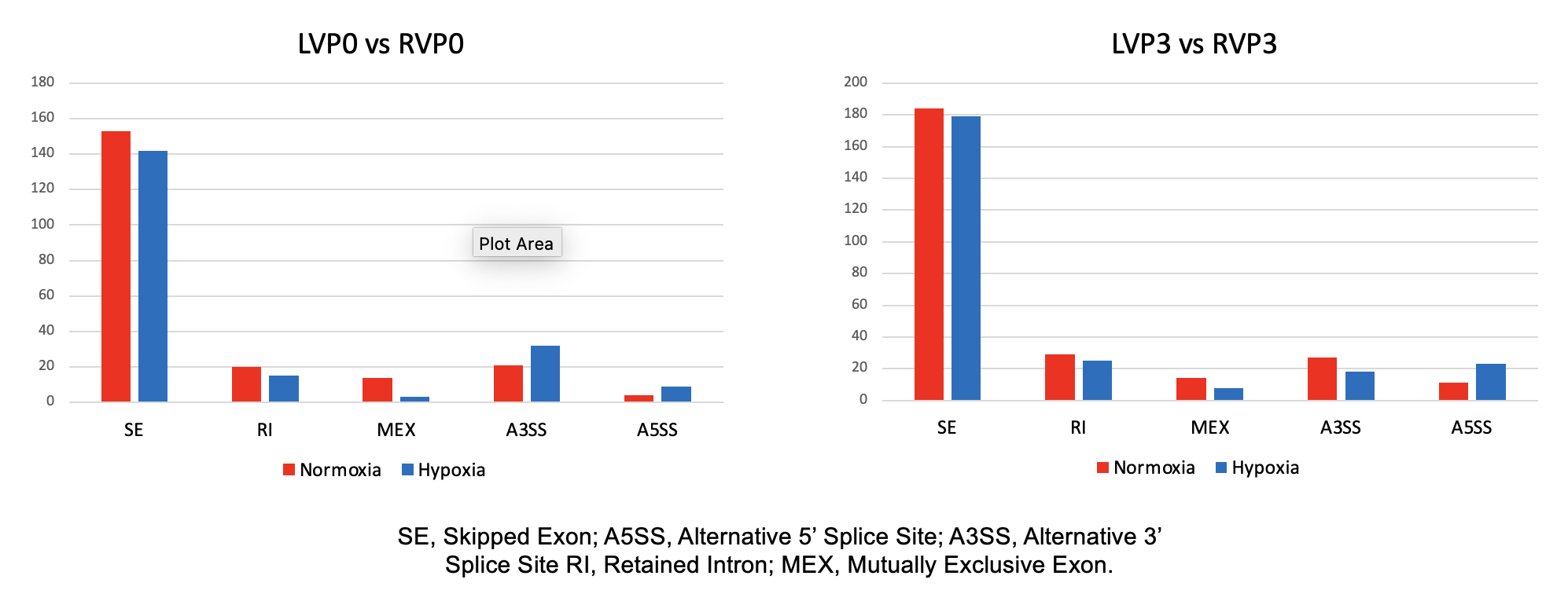Genomics/Epigenomics
Category: Abstract Submission
1: Genomics/Epigenomics I
6 - Impact of Hypoxia on Alternative Splicing in Left vs Right Ventricle During Perinatal Circulatory Transition
Friday, April 22, 2022
6:15 PM - 8:45 PM US MT
Poster Number: 6
Zubin Mehta, UCLA Mattel Childrens Hospital, santa Monica, AL, United States; Marlin Touma, University of California, Los Angeles David Geffen School of Medicine, Los Angeles, CA, United States

Zubin Mehta, MD
Fellow
UCLA Mattel Childrens Hospital
University of California Los Angeles David Geffen School of Medicine
santa Monica, Alabama, United States
Presenting Author(s)
Background: Alternative splicing (AS) of messenger RNA (mRNA) is known to play an important role in normal and abnormal cardiac development. Distinct transcriptomic profiles between the left ventricle (LV) and right ventricle (RV) have been documented under both normal and hypoxic conditions. Hypoxia is known to be a key driver of AS changes in a variety of tissues, but how AS responds to hypoxia in the neonatal heart chambers remains a key unexplored question, and may have important clinical applications in newborns with cyanotic congenital heart defects.
Objective: We aimed to profile genes that are alternatively spliced in the left vs right ventricle during both normal and hypoxic perinatal transition. We also sought to Identify putative hypoxia-induced splicing factors that may control chamber specific regulation of AS in response to perinatal hypoxia.
Design/Methods: To induce hypoxia, neonatal mouse pups (C57BL/6) were reared with their dams in 10% FiO2 using a BioSpherix OxyCycler normobaric hypoxia chamber and maintained until the pre-decided end points. To compare the transcriptome of hypoxic vs normoxic heart tissue, deep RNA-seq was performed on LV and RV at two time points of perinatal circulatory transition: P0 and P3. AS events were identified and quantified using rMATs (robust Multivariate Analysis of Transcript splicing). For functional assessment, gene ontology (GO) analysis was performed.
Results: 11622 significant AS events were identified during perinatal heart maturation under normoxic conditions, compared to 1296 AS events under hypoxic conditions. A vast majority (78%) of these events were specific to either normoxic or hypoxic conditions. Although some events overlapped under both - conditions, these events exhibited different patterns of regulation between LV and RV throughout the perinatal circulatory transition based on hypoxia condition, including key transcription factors and signaling molecules. Further characterization of the differentially spliced exon skipping events in LV vs RV, using GO analysis, revealed significant changes in functional enrichment terms at P3. Transcriptional regulation and cell cycle processing were enriched terms in the hypoxia condition, while ion transport, structural proteins, and intercellular signaling were enriched terms in the normoxic condition.Conclusion(s): These results suggest that hypoxia induces significant changes in alternative splicing patterns during postnatal heart maturation. Additional bioinformatic and mechanistic studies of potential splicing regulators may reveal targets for cyanotic congenital heart disease.
Figure 1 Normoxic vs Hypoxic Distribution of Significant Alternative Splicing Events During Perinatal Heart Maturation
Normoxic vs Hypoxic Distribution of Significant Alternative Splicing Events During Perinatal Heart Maturation
Figure 2.png) Gene Ontology (GO) of AS Genes Reveals Specific Enrichment in Normoxia vs Hypoxia
Gene Ontology (GO) of AS Genes Reveals Specific Enrichment in Normoxia vs Hypoxia
Objective: We aimed to profile genes that are alternatively spliced in the left vs right ventricle during both normal and hypoxic perinatal transition. We also sought to Identify putative hypoxia-induced splicing factors that may control chamber specific regulation of AS in response to perinatal hypoxia.
Design/Methods: To induce hypoxia, neonatal mouse pups (C57BL/6) were reared with their dams in 10% FiO2 using a BioSpherix OxyCycler normobaric hypoxia chamber and maintained until the pre-decided end points. To compare the transcriptome of hypoxic vs normoxic heart tissue, deep RNA-seq was performed on LV and RV at two time points of perinatal circulatory transition: P0 and P3. AS events were identified and quantified using rMATs (robust Multivariate Analysis of Transcript splicing). For functional assessment, gene ontology (GO) analysis was performed.
Results: 11622 significant AS events were identified during perinatal heart maturation under normoxic conditions, compared to 1296 AS events under hypoxic conditions. A vast majority (78%) of these events were specific to either normoxic or hypoxic conditions. Although some events overlapped under both - conditions, these events exhibited different patterns of regulation between LV and RV throughout the perinatal circulatory transition based on hypoxia condition, including key transcription factors and signaling molecules. Further characterization of the differentially spliced exon skipping events in LV vs RV, using GO analysis, revealed significant changes in functional enrichment terms at P3. Transcriptional regulation and cell cycle processing were enriched terms in the hypoxia condition, while ion transport, structural proteins, and intercellular signaling were enriched terms in the normoxic condition.Conclusion(s): These results suggest that hypoxia induces significant changes in alternative splicing patterns during postnatal heart maturation. Additional bioinformatic and mechanistic studies of potential splicing regulators may reveal targets for cyanotic congenital heart disease.
Figure 1
 Normoxic vs Hypoxic Distribution of Significant Alternative Splicing Events During Perinatal Heart Maturation
Normoxic vs Hypoxic Distribution of Significant Alternative Splicing Events During Perinatal Heart MaturationFigure 2
.png) Gene Ontology (GO) of AS Genes Reveals Specific Enrichment in Normoxia vs Hypoxia
Gene Ontology (GO) of AS Genes Reveals Specific Enrichment in Normoxia vs Hypoxia